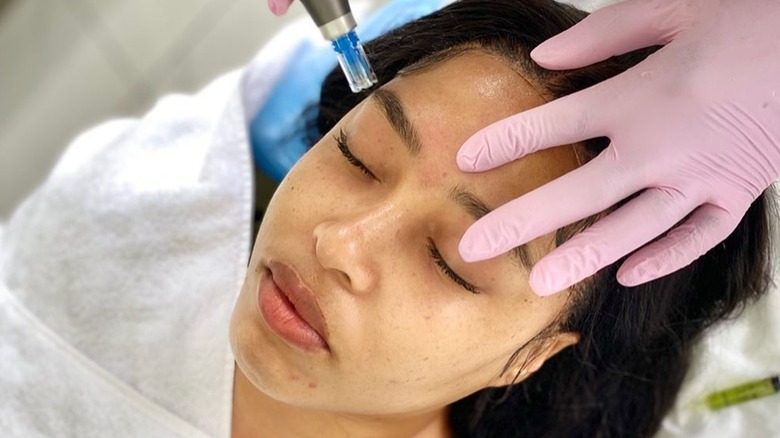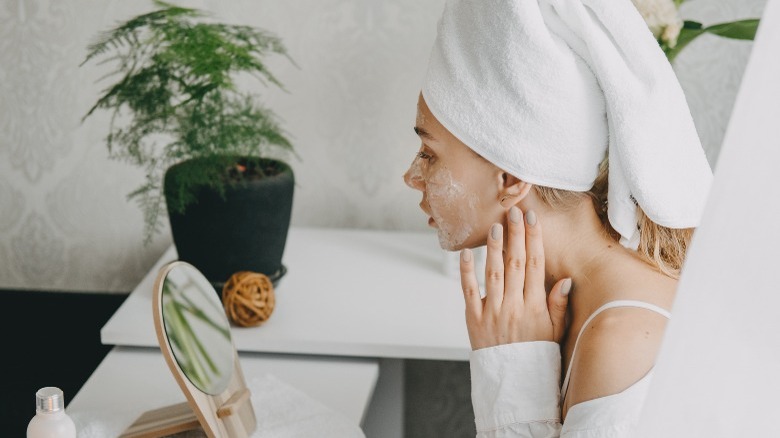Why You Should Avoid Retinol And Other Active Ingredients After Microneedling
Microneedling has become a common treatment for a variety of skin problems in the last few years. For example, microneedling is said to reduce the appearance of acne scars, fine lines, and even wrinkles.
Mary Stevenson, MD, a specialist in dermatologic surgery and cosmetic dermatology, explains to Vogue the needle-inserting skin procedure, "The needles range from 0.5–2.5 mm and rotate over the skin from a pen-like device, which creates tiny wounds that breach the stratum corneum — the top-most layer of the skin — to reach the epidermis and deeper dermis."
By creating these microscopic ruptures in the top layer of the skin, according to Cleveland Clinic, the body is encouraged to produce more collagen in order to heal them. Microneedling should ideally be done by a medical professional, even though it's a non-invasive skin treatment, but you can also do it yourself with a dermaroller. Additionally, before you try microneedling, you should know that your current skincare routine might need some changing in the aftercare period.
Avoid active skincare ingredients in the first few days post-treatment
A medical professional should provide all the aftercare instructions and answer any questions you might have. However, if you opt for the at-home microneedling route, make sure you're equally informed about the dos and don'ts of caring for your skin in its recovery phase.
If your skincare routine involves an active ingredient, you shouldn't use it in the first few days post-treatment. "An active ingredient is something that should make a change in your skin, and it can be delivered any way," Deirdre Hooper, co-founder of Audubon Dermatology, explains for Today. According to Smita R. Ramanadham, MD, a double board-certified plastic surgeon, you should steer clear of AHAs and BHAs, as well as vitamin C and retinoids of any kind, including retinol (via Byrdie).
Active ingredients are too harsh after a treatment like microneedling and can further stress your skin out, causing inflammatory reactions. You should give your skin a break in every way possible. "For the rest of the day [after microneedling], don't wash the skin, expose it to high heat, or sweat too much (that means no sun, no gym, no hot yoga)," Yale clinical professor and dermatologist Mona Gohara, MD, tells Elle.
What to use instead to help your skin heal better
In the first few days after the microneedling procedure, you'll want to ease back into skin care. Look for a fragrance-free, mild cleanser, and don't forget to hydrate the skin, as that will help the healing process along. According to Dendy Engelman, MD, a board-certified cosmetic dermatologist and surgeon, hyaluronic acid is a good choice to amp your skin's hydration levels up.
After five to seven days post-treatment, you should be able to go back to at least some of your usual skincare routine. Dermatologist Amanda Doyle, MD, tells Byrdie it's super important to check with your microneedling practitioner to make sure your skin's barrier is completely repaired before using any of your usual active skincare ingredients. If given the green light, you should still proceed with caution to make sure none of them cause an unwanted reaction.
Even though caring for your skin after microneedling is no joke and you can actually cause more harm than good if you don't follow the aftercare instructions, most people say it's so worth it. After all, it's a small sacrifice to make for that new skin glow.

